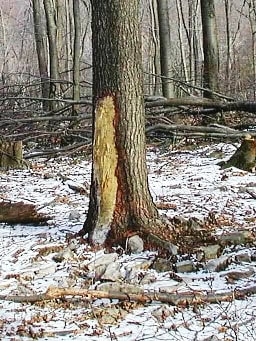
FOREST OPERATIONS >> RESIDUAL STAND PROTECTION
 During a harvesting operation it is easy to become more focused on the trees that are coming off the forest than the ones that remain. However, after the log trucks are gone the residual stand is what will be left behind to meet a landowner’s management objectives. Treatments should leave the forest in better condition than it was before the activity was undertaken. During an operation the risk of damaging the residual stand is very high. Careless operations that result in damaged trees or unnecessary impact to the soil resource can result in decreased tree vigor and quality and significantly degrade the volume and value of the future forest. Proper planning can minimize the chances of damaging or degrading the residual stand during forest operations. Some practical steps can be taken to prevent residual stand damage:
During a harvesting operation it is easy to become more focused on the trees that are coming off the forest than the ones that remain. However, after the log trucks are gone the residual stand is what will be left behind to meet a landowner’s management objectives. Treatments should leave the forest in better condition than it was before the activity was undertaken. During an operation the risk of damaging the residual stand is very high. Careless operations that result in damaged trees or unnecessary impact to the soil resource can result in decreased tree vigor and quality and significantly degrade the volume and value of the future forest. Proper planning can minimize the chances of damaging or degrading the residual stand during forest operations. Some practical steps can be taken to prevent residual stand damage:

During a harvesting operation it is easy to become more focused on the trees that are coming off the forest than the ones that remain. However, after the log trucks are gone the residual stand is what will be left behind to meet a landowner’s management objectives. Treatments should leave the forest in better condition than it was before the activity was undertaken. During an operation the risk of damaging the residual stand is very high. Careless operations that result in damaged trees or unnecessary impact to the soil resource can result in decreased tree vigor and quality and significantly degrade the volume and value of the future forest. Proper planning can minimize the chances of damaging or degrading the residual stand during forest operations. Some practical steps can be taken to prevent residual stand damage:
- Focus on protection of the residual stand rather than on the trees being removed.
- During intermediate operations, retain seed source of species needed to achieve long-term management objectives.
- Avoid intermediate cuttings that may increase interfering plant communities, such as grasses and ferns, or be prepared to treat interfering vegetation before the regeneration cut.
- Design and lay out skid trails and skid roads to minimize damage by avoiding residual trees and using bumper trees to protect them from skidding damage.
- Exercise special care when harvesting trees during the growing season (usually between April and August), when residual trees are most susceptible to felling and skidding damage.
- Identify and mark unique vegetation to be protected.
- Ensure that a stand compatible with long-term management objectives remains after intermediate treatments.
- Rather than selecting trees for cutting, select for retention.
- Avoid high-grading (See also TUSAF)
ADDITIONAL RESOURCES:
- Practices to Minimize Logging Injuries to Residual Trees
- PA SFI Treatment Unit Sustainability Assessment Form
- PA SFI Timber Harvesting Assessment Form
- Best Management Practices for Pennsylvania Forests [See residual stand protection]
- Diameter-Limit Cutting and Silviculture in Northeastern Forests: A Primer for Landowners, Practitioners and Policy Makers
- A Damaging Tradition: Diameter-Limit Cutting Diminishes a Woodlot
- High Grade Harvesting: Understand the Impacts, Know your Options
- High Grade Timber Harvesting Bad News for Forest Landowners [Video]
- Just Say No to High‐Grading, Selective Cutting, and Diameter‐Limit Cutting
- Regenerating a High-Graded Stand [Webinar]
- Seeing Past the Green: Managing High-Graded Woodlots [Webinar]

